 |
| Dried California Pearly Everlasting. The flowers are small, about the size of a buttons on a shirt collar. |
Last summer I was happy to be able to take a class on native plant use taught by Cecilia Garcia and James Adams, co-authors of Healing with Medicinal Plants of the West. One of the many things I learned in this class was that the flowers of California Pearly Everlasting, Gnaphalium californicum, aka cudweed aka rabbit tobacco, are supposed to be good for colds.
I’ve not had a chance to try it until this week. I’ve only had one cold since last summer, and that one hit so fast and hard I just sort of gave up on doing anything but riding it out. The one I have this week is more of a typical head cold, and a good chance for a field test. And I can say that I think they helped. But I’m not sure how.
My confusion is a result of memory vs. notes. I remember James saying he takes this tea instead of Day Quill whenever he has a cold. So, having the flowers on hand, I took the tea expecting it to act like cold medicine. Because the effects are so subtle (unlike cold capsules) I didn’t think my first cup was doing anything at all–until I realized I’d stopped sneezing and constantly blowing my nose. The relief lasted for a few hours. When I started feeling crappy again, I had another cup and the symptoms retreated again. Over the course the first day I had 3 cups. The next day, I felt much better. My symptoms were less, though I did still feel “under siege” and retreated to bed early.
During the course of that day, I dug out my class notes and discovered that Cecilia said something different than what I remembered–she said that Everlasting is an immune stimulant, and when you have a cold you’re supposed to take one cup (one!) before bed for 4 nights. It has to be 4 cups over 4 nights, even if you feel better. No more, no less. So she’s using it more like Echinacea–not as a symptom relief. Meanwhile, random internet searches affirm that it’s good for colds, but don’t say how.
Since my symptoms were better from day 2 on, I reverted to Cecelia’s advice and took one cup before bed for the remaining 3 nights. The cold symptoms remained at bay, though I could feel the fight in my body. After a few days it was all over.
So if I experienced symptom relief, was it psychosomatic? Was the cold mild because of immune stimulation or because it wasn’t much of a cold? I really don’t know, but I’m going to keep taking the tea when cold symptoms arise.
Best as I can figure, herbal medicine is all about developing a relationship with the plant, and all I’ve had so far is a brief introduction. More research is required, but I’m intrigued.
If you see Everlasting while out walking, bring some home and try it out and let me know what you think.
How to make the tea:
Add as many dried flower heads as will fill the hollow of your palm (7 or so? A very modest amount–Cecelia was adamant about that) to 1 cup of boiling water. Cover the cup and let it sit for 10 minutes or so–a good long steep. It doesn’t taste bad. It does have the curious effect of sort of drying out the back of my throat–but not so much that it’s uncomfortable.
As far as I know it doesn’t have any harmful effects, but as always, be careful.
About the plant:
 |
| Photo by Curtis Clark |
Gnaphalium californicum grows on the west coast, from Baja up to Washington. It’s a knee high or so, with green foliage and white flowers in the spring. By summer/fall it has dried out and displays clusters of perfectly formed little dry flower heads. This is the reason for its name, Everlasting. It makes everlasting dried flower arrangements.
Look for it in disturbed places, hillsides, construction areas and the like, because it’s a pioneer plant. If you want to grow it, it is available through native plant suppliers.
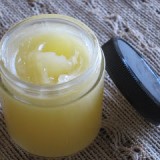
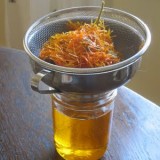
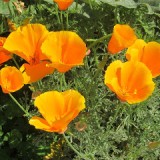
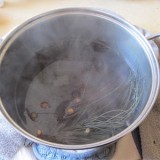
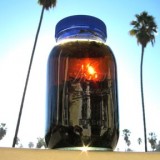
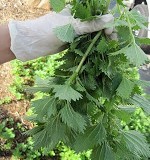
Here in the South, we have rabbit tobacco. Nope, rabbits don’t smoke it; little boys do. since there are about 25 members of this genus, I wonder if all have the same medicinal properties. I did look it up to find that there were so many members, but I went no further. It seems our ten acres were full of this, but that is all I remember, not where it grew, disturbed land or not. I do remember my brother smoked it. Do you know if all rabbit tobacco has the same medicinal qualities?
Unfortunately I have no idea. There are a lot of related plants and I guess the only way to find out would be to research local folkways and indigenous uses of the plants.
And not for you, Parsimony, because I think you know the difference– but for anybody else reading this, remember that you can’t rely on common names to ID plants. Many different types of plant are called “rabbit tobacco” for instance. Unless you can id the plant as Gnaphalium californica then I can’t recommend it for use.
I did not do much investigation beyond finding 25 or so things with the same genus called “rabbit tobacco” and “cudweed.” I may or may not know the difference.
Look at the usda site. http://plants.usda.gov/java/profile?symbol=PSEUD43
It is an interesting site with maps of the genus. I wonder if they have these state maps for all plants. Yours is called “ladies tobacco” according to the site. However, that name alone does not mean it is not “rabbit tobacco.” There are no multiple names on any of the members of the genus.
Now, I really want to know more. I may call Auburn University and ask questions.
I’m always suspicious of things that claim to be “immune stimulants” – that’s another way of saying “allergen.”
I like to eat elderberries for my flue symptoms. they have been proven by science to reduce flu symptoms.